Although natural breasts are all different shapes and sizes, breast deformities can cause significant psychological distress. This is why some people get corrective surgery to improve the appearance of their breasts. A small breast size, droopy breasts, large areolas or breast asymmetry are common concerns and can be fixed with surgery. However, these are also standard features of tuberous breast deformities. Tuberous breasts need a specialist surgical approach to fix, so you must determine whether you have the condition before getting surgery.
In this article, we cover the different types of tuberous breasts and outline the main features of each type. Next, we discuss the possible and known causes of these breast deformities and the possible treatment options. We explore treatment options without breast implants for those looking for the most natural breast shape.
Click on one of the links to jump to that section
-
What are the different types of tuberous breasts?
There are five types of tubular breast deformity and three grades of asymmetry
-
What are the causes of tuberous breasts?
Here, we discuss the known causes of a tuberous breast deformity
-
Can you fix tuberous breasts?
This section discusses tuberous breast correction surgery options, including no breast implants.
What are the different types of tuberous breasts?
Tuberous breasts are usually diagnosed symptomatically, and the types are categorised by their physical traits. These traits include the following:
- A conic, oval or cylindrical shape
- Constricted breast tissue
- A small breast base,
- Insufficient breast development (breast hypoplasia) in the lower portion of the breast
- Protruding/herniated areolas
- Breast asymmetry.
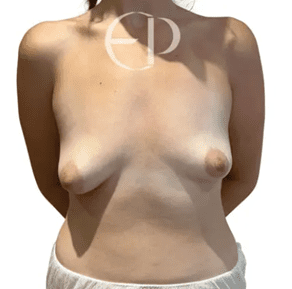
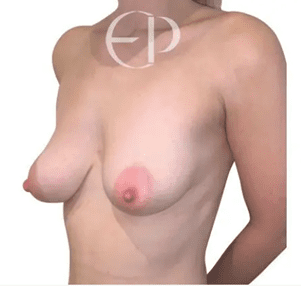
Research has identified four main types of tuberous breast deformity that increase in severity: type I, type II, type III and type IV. A new classification (type 0) was added, which displays altogether different characteristics. The standard features of each type are detailed below:
- Type I – under-development in the lower and inner portions of the breast, low breast volume and potentially wide-set or outward-pointing breasts.
- Type II – Underdevelopment in the breast’s lower, inner and outer portions with a conic or oval shape and slight breast drooping. Type II breasts may lack volume.
- Type III – underdevelopment in the outer, inner and lower portions of the breast, a skin deficiency under the areola causing them to sit very low or point downwards. Droopy, oval or conic breasts and large, building nipples/areolas.
- Type IV – Instead of underdevelopment or skin deficiency, type IV is characterised by a small breast base, constricted breast tissue, a cylindrical or oval shape and bulging areolas.
- Type 0 – women with this type of breast deformity can have a normal breast base and volume but with large, building or herniated nipples and areolas.
Grades of breast asymmetry
In addition to the five types of tuberous breasts, there are different levels of asymmetry: mild, moderate and severe.
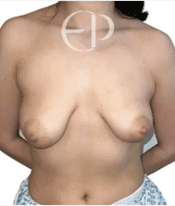
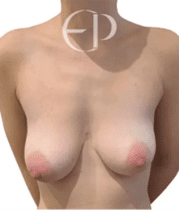
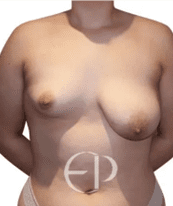
With a mild asymmetry, there is less than a 200g difference between breasts; moderate describes a 200-400g difference between breasts. A severe asymmetry will have over 400g difference in breast weight.
Read more about the types of tuberous breasts
Think you have tuberous breasts? Book a consultation
What are the causes of tuberous breasts?
Currently, there are no definitive causes of tuberous breasts; however, evidence suggests that the condition originates before birth and could result from genetic factors. One researcher found that a pair of identical twins developed a tuberous breast deformity, but this doesn’t prove that the cause is genetic.
There is more understanding surrounding the causes of the symptoms themselves. The common denominator for almost every tuberous breast deformity is a weakness in the nipple-areola complex. This weakness causes the nipple and areolas to bulge forward, creating an oval shape rather than a teardrop.
Another common cause of the tubular breast shape is the excess collagen fibres surrounding the breast parenchyma, constricting the tissue. This prevents the breasts from developing in horizontal and vertical directions. Instead, the breast tissue herniates through the nipple-Areola complex, creating the characteristic tubular shape and small breast base.
Read more about the causes of tuberous breasts
Can you fix tuberous breasts?
A breast deformity can cause significant distress, and many seek aesthetic plastic surgery to alter their appearance and improve self-confidence. Unfortunately, correcting a tuberous breast syndrome without breast surgery is impossible. Even less invasive procedures, such as fat grafting (fat transfer), are unsuitable for this kind of breast deformity because of the fibrous restriction and nipple herniation.
You will need to visit a specialist plastic surgeon in tuberous breast surgery because it is essential to address the causes of the deformity before changing the breast size and shape. A simple breast augmentation will leave the patient with a more prominent deformity if the constriction and herniation are not addressed.
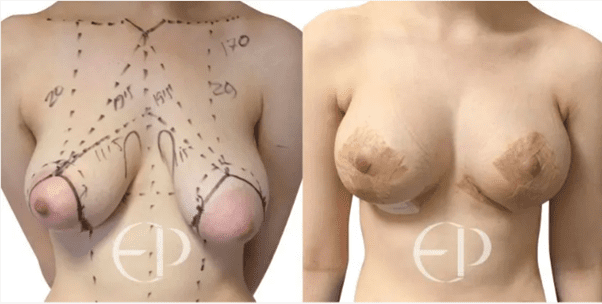
What are the options for tuberous breast correction?
Breast reconstruction will be required to correct deformity types I-IV. The plastic surgeon will release the constricting ring of fibrous tissue surrounding the breast; in some severe cases, the breast tissue can be redistributed using pedicled flaps to give a more aesthetic breast shape. In cases where the breasts significantly lack volume (and if the patient desires), breast implants can be used to provide the patient with larger breasts. For large, bulging areolas, nipple reduction procedures may be necessary. Finally, a mastopexy (breast lift) may be appropriate for very droopy breasts with an elevated inframammary fold. The different procedure options are outlined.
- Breast remodelling
- Nipple reduction
- Breast lift
- Male breast reduction (gynaecomastia)
Learn about your corrective surgery options for tuberous breasts
Sources
-
Tuberous Breast: Revised Classification and a New Hypothesis for its Development
-
Review of Tuberous Breast Deformity: Developments over the Last 20 Years
-
Tuberous Breast: Revised Classification and a New Hypothesis for its Development
-
Tuberous breast: Morphological study and overview of a borderline entity




